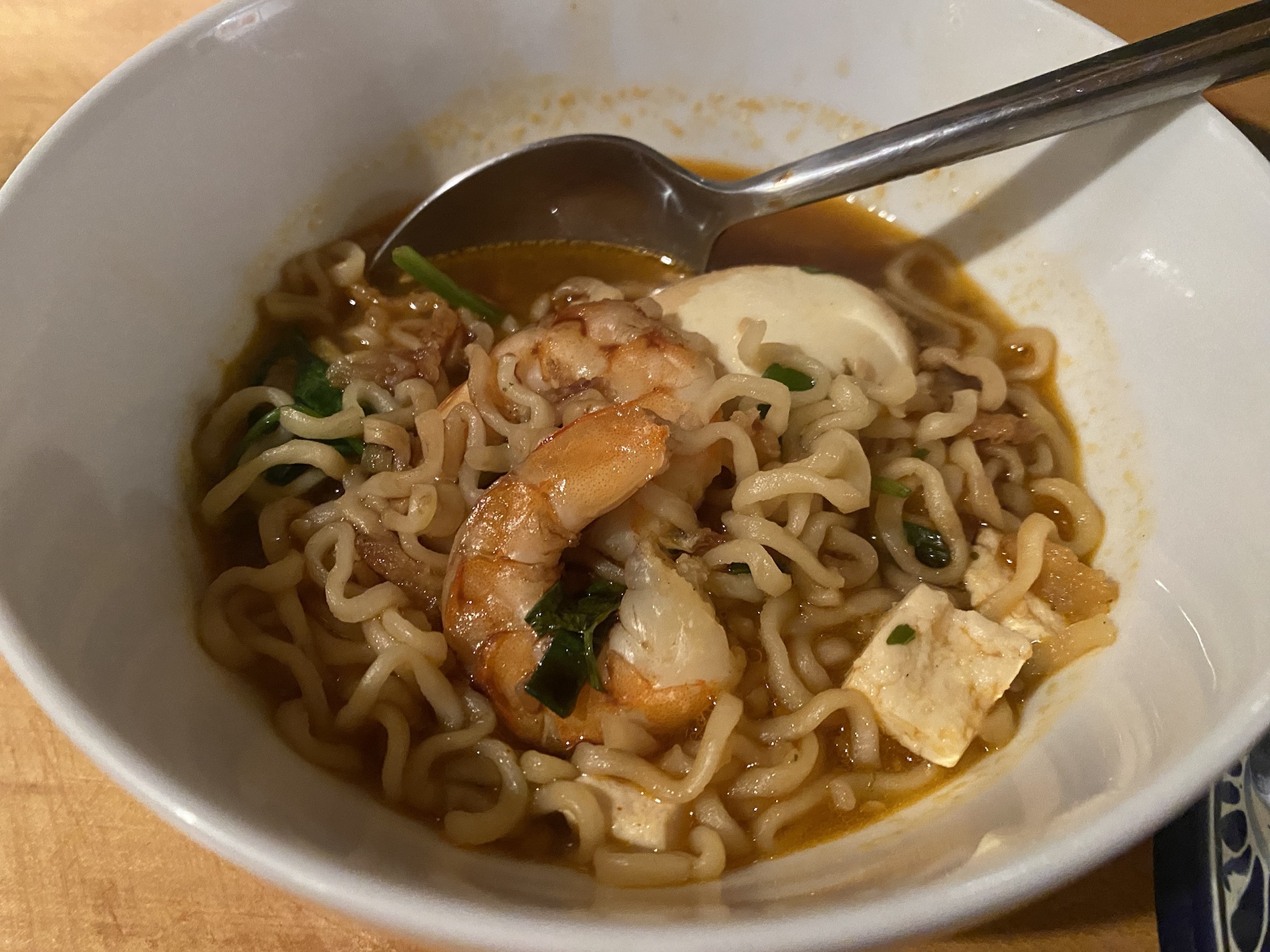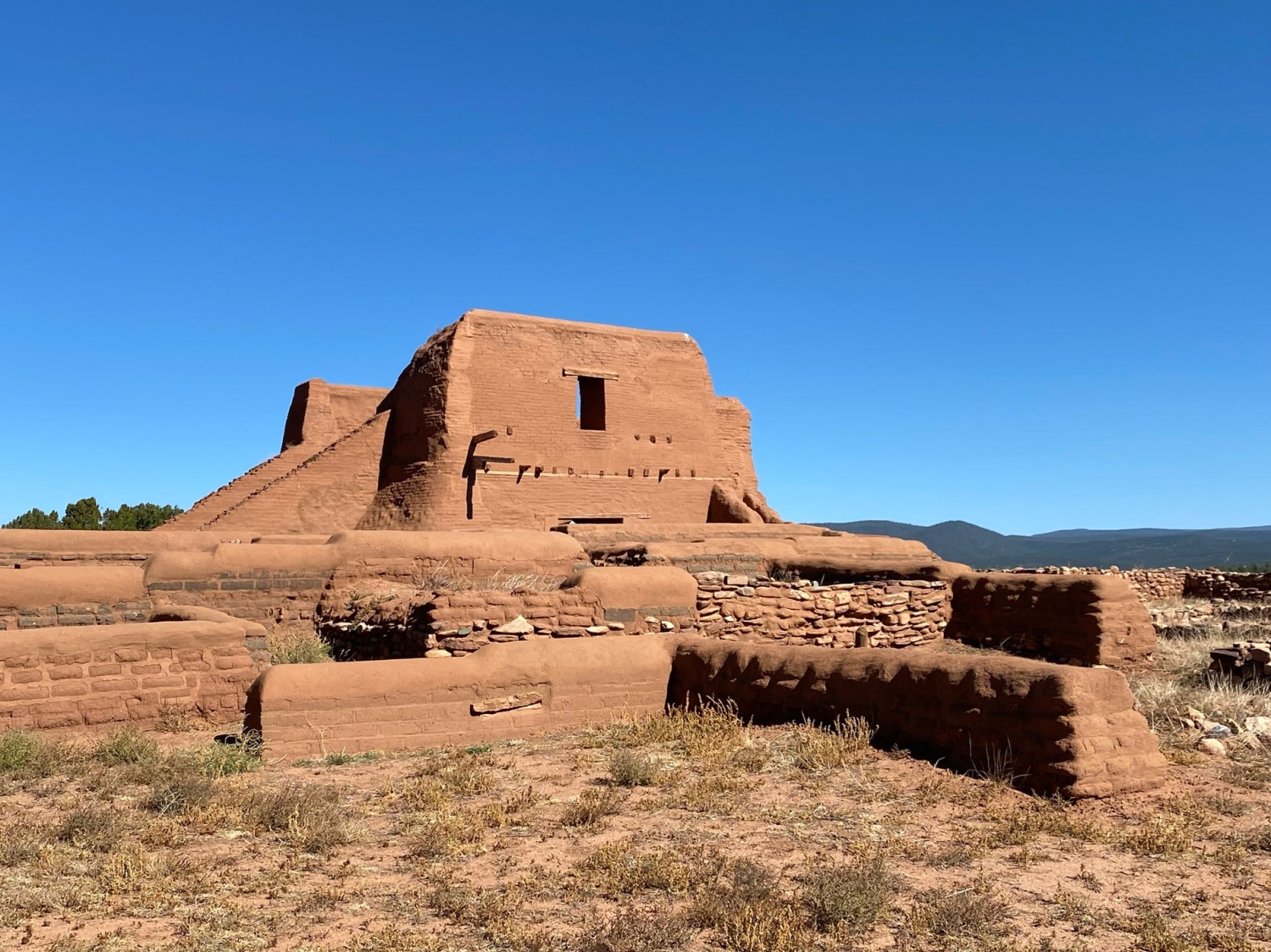Sunday, October 22, 2023: This morning, after having a leisurely breakfast in our Santa Fe Airbnb, we decided, since it was a Sunday and downtown Santa Fe was sure to be crowded, to instead explore all the places outside of Santa Fe that we wanted to see.
Pecos National Historical Park
We started by going to Pecos National Historical Park, which preserves what was once a cultural crossroads through which hunters and gatherers, traders, conquerors and explorers, immigrants, soldiers, ranchers and tourists passed.
Because of the village’s commanding location near Glorieta Pass, Pecos Pueblo hosted a lively trade between the Plains Indians hunting to the east and Rio Grande Pueblos farming to the west. Situated on a high ridge near abundant water supplies, it grew into one of the largest and most powerful pueblos, rising four to five stories high and home to some 2,000 people.
The Pecos people’s life and traditions were deeply rooted in ancient Puebloan customs and religious beliefs. Kivas (underground ceremonial rooms) were connections to the spiritual world. The people believed prayers, rituals and offerings brought good fortune and helped maintain balance and harmony in all things. The Pecos followed ancestral farming practices and set aside food for the winter in massive storerooms.
Despite the emphasis on harmony, warfare was common. With 500 warriors, Pecos was considered the dominant power, as newcomers to the region soon realized.
By the mid-1500s, this prominent pueblo, known throughout the Pueblo world, had become an attractive target for the Spanish Conquistadors during their explorations of the Southwest. Coronado visited in 1541. The Spanish established a mission here after they settled here in 1598. Padre Ortiz built the first church around 1617 or 1618 in the rocky hills outside the pueblo. A few years later, in 1625, a new, much larger second church was completed south of Pecos Pueblo.
Arrival of the Spanish brought sweeping changes that drastically altered the lives of the Pecos people. By 1680, years of Spanish control, famine, disease and Apache raids had taken a toll on the Pecos and other Pueblo people. Spaniards had tried to eradicate every aspect of ancestral Pueblo life.
Po’pay (1630-88), a Pueblo religious leader, wanted to end Spanish domination of the Pueblo world. His message was prosperity and independence. He secretly united many of the separate Pueblos to rise up against the Spaniards. On August 10, 1680 the Pueblos revolted, driving out the Spaniards. The church at Pecos was destroyed. The Pueblo people’s revolt against the Spanish resulted in the only successful expulsion of a European colonizer in the New World.
Still, rain didn’t come to water their crops and peace didn’t prevail because of increasing raids by the Apache and Navajo. Once the Comanche started raiding Pueblo settlements, little hope remained for a peaceful existence.
By 1692, the Spanish had returned but this time they took a more conciliatory approach with the Pueblo people and their traditions. In 1717, Spaniards and Puebloans worked together to build a smaller church on the site of the one that had been destroyed.
By the late 1700s, the region’s population decreased due to drought, disease, migration and Comanche raids.
The governor of New Mexico Juan Bautista de Anza led a campaign against the Comanche in 1779 and signed a formal peace treaty at Pecos Pueblo on February 28, 1786.
In 1838, the few remaining Pecos inhabitants moved to Jemez Pueblo, where descendants still live today. As the century came to an end and new territories formed, thousands of settlers traveled past the phantom remains of the once powerful Pecos Pueblo.
We walked all around the Pueblo ruins and saw remnants of the second church’s foundation. Its buttressed stone foundations are the only visible remains. They stretch 150 feet from altar to entrance and are 22 feet thick in places. The church functioned for 55 years.
Lunch at Harry’s Roadhouse
After visiting Pecos National Historical Park, we took Brooke’s advice and went for brunch at Harry’s Roadhouse. Luckily it was nearing the end of the Sunday brunch hour, and the lunch hour hadn’t yet started yet, so we were able to sit out on the patio. I had the most delicious Lemon Ricotta Pancakes with Fresh Strawberries 🍓 🍓 🍓 and Mike had Mexican Chilaquiles with Tomatillo Salsa, Queso Asadero and Cotija, with Eggs over medium and Black Beans. In our typical fashion, we shared halves. It was a very pleasant experience, just as Brooke had promised it would be.
Los Alamos and the Manhattan Project National Historical Park
After our brunch, we drove up to Los Alamos to visit the Manhattan Project National Historical Park. This park is comprised of three locations: Project Y at Los Alamos, New Mexico; Site X at Oak Ridge, Tennessee; and Site W at Hanford, Washington. Project Y at Los Alamos was an ideal remote location for the top-secret program during World War II to design and build an atomic bomb. It sits isolated on top of a mesa, with canyons cutting through the surrounding landscape.
During the Manhattan Project, top scientific minds of the time lived in Los Alamos: Dr. J. Robert Oppenheimer, Hans Bethe, and many more. These scientists developed the theoretical and experimental tests and created the first atomic weapons, using enriched uranium from Oak Ridge and plutonium from Hanford. Today, the nucleus of this once-secret city is still Los Alamos National Laboratory.
We took the Los Alamos Downtown Historic Sites Walking Tour after a brief stop at the Visitor Center. As it was Sunday, some of the sites weren’t open. We saw the Ice House Memorial, from the Ranch School’s original ice house (torn down in 1957), where scientists assembled the nuclear components of the Trinity gadget, the first tested nuclear device. We walked by Ashley Pond, named after the founder of the Los Alamos Ranch School, which is now a public park. We dropped into the Fuller Lodge, built in 1928 as a dining hall for the Los Alamos Ranch School. During Project Y, the lodge hosted community activities for lab employees. The Los Alamos History Museum was closed, but we walked down Bathtub Row, adapted for use by the scientists. These were the only homes in town with bathtubs during WWII. One housed chemist Edwin McMillan and physicist Hans Bethe, both Nobel Prize winners; the other housed the Oppenheimer family.
We had seen the film Oppenheimer before coming to New Mexico, so it was interesting to see some of these sites.
Bandelier National Monument
After leaving Los Alamos, we went to Bandelier National Monument to see its spectacular canyon and mesa landscape. Over a million years ago, an eruption of the Jemez Volcano covered hundreds of square miles with ash flows, creating a broad plateau. Erosion quickly cut sheer-walled canyons into the plateau, resulting in Bandelier’s canyon-and-mesa landscape.
It was home to hunter-gatherers for thousands of years and home to Ancestral Pueblo people from the mid-1100s to the mid-1500s. Ancestral Pueblo people were farmers who grew maize (corn), beans and squash. They also ate native plants and hunted birds, as well as deer, rabbits and other mammals. These people carved hundreds of cave rooms into the walls of Frijoles Canyon during their 400-year occupancy here.
From the 250 years beginning in the mid-1200s, fewer and larger villages were established, with some exceeding 400 rooms. In Bandelier, the villages of Tyuonyi and Tsankawi and their adjacent human-excavated caves, are from this period. The people had moved to villages along the Rio Grande by the mid-1500s and soon after, the Spanish colonized New Mexico, causing a great disruption to the indigenous people of the Southwest.
We walked around the Pueblo Loop Trail, checking out the cliff dwellings and the Long House, as well as Tyuonyi and the Big Kiva.
Santa Fe
On our hour-long drive from Bandelier back to Santa Fe, we called and ordered takeout food from a fabulous place right in old town Santa Fe, The Wrap, which offers a fusion of Asian and New Mexican food. Mike got a Chibached panini: Chicken, bacon, green chili, avocado, cheddar, & spicy mayo. I got Fire Ramen Noodle Soup with shrimp: Cilantro, green onion, hard-boiled egg, jalapeno, tofu, sesame & sesame oil, fresh spinach, crispy fried onion, and lemon in spicy bone broth.
We took the dinner to our Airbnb and after soaking in the hot tub with our Vodka tonics, we heated it all up and enjoyed a delicious dinner after a long busy day.

Fire Ramen Noodle Soup with shrimp
Steps: 12,577; miles 5.33. Drove 160.2 miles. Weather Hi 76°, Lo 43°.
Discover more from ~ wander.essence ~
Subscribe to get the latest posts sent to your email.






























































































An interesting day – as usual, you packed loads in! The Manhattan Project part made it quite varied too.
LikeLike
It is so beautiful and interesting in these parts of New Mexico, Anabel. We really loved this day and our day following in Santa Fe’s historic town. The Manhattan project is certainly interesting, especially after seeing the movie Oppenheimer.
LikeLiked by 1 person
That’s one of my favorite areas! 🙂 Looks like you had a wonderful time
LikeLike
Isn’t it one of the most beautiful places in the U.S.? I’m glad you enjoyed it too. I could live there so easily.
LikeLiked by 1 person
So interesting to learn all these new stories.
LikeLike
Thanks, Carol. It was very interesting to learn about all the historical things that happened in this part of the U.S. It almost seems a different world.
LikeLiked by 1 person